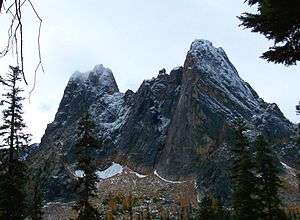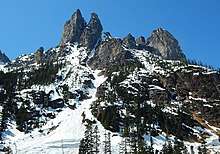Liberty Bell Mountain
Liberty Bell Mountain is located in the North Cascades, approximately one mile south of Washington Pass on the North Cascades Highway. Liberty Bell is the most northern spire of the Liberty Bell Group, a group of spires which also includes Concord Tower, Lexington Tower, North Early Winters Spire, and South Early Winters Spire.
| Liberty Bell Mountain | |
|---|---|
 Liberty Bell Mountain above Washington Pass | |
| Highest point | |
| Elevation | 7,720+ ft (2,350+ m) NGVD 29[1] |
| Prominence | 200 ft (60 m) [1] |
| Coordinates | 48°30′55″N 120°39′28″W [2] |
| Geography | |
| Location | near Washington Pass, Chelan / Okanogan counties, Washington, U.S. |
| Parent range | North Cascades |
| Topo map | USGS Washington Pass |
| Geology | |
| Type of rock | Granite |
| Climbing | |
| First ascent | 1946, Fred Beckey, Jerry O'Neil, and Charles Welsh |
| Easiest route | class 5.6 The Beckey Route |
It is a well known peak in Washington, although it lacks high prominence, and elevation. It is well known for having high quality alpine climbing, with a short approach since the completion of The Washington Pass Hwy. A mixture of high quality granite and difficult rock, has made it a very popular weekend climbing area. Routes range from 5.6 class and grade II, to 5.12a class, and grade IV to V.[3]
Rock Climbing Routes
Liberty Bell Mountain features 18 named traditional climbing routes.[4] Liberty Crack is featured in Fifty Classic Climbs of North America.[5] The first ascent was on September 27, 1946 by Fred Beckey, Jerry O’Neil, and Charles Welsh by way of what is now known as the Beckey route.[4]
Climbing Routes on Liberty Bell Mountain[6]

- Beckey Route (SW Face) - class 5.6 - 3 pitches
- Freedom or Death - class 5.12a - 4 pitches
- A Slave To Liberty - class 5.13- - 11 pitches
- NW Face - class 5.9 - 5 pitches
- Serpentine Crack - class 5.11 - 4 pitches
- The Girl Next Door - class 5.9- - 3 pitches
- Rapple Grapple - class 5.8 - 4 pitches
- Overexposure - class 5.8 - 2 pitches
- Freedom Rider - class 5.10d - 14 pitches
- Liberty Crack - class 5.11a - 12 pitches
- Liberty Crack Free - class 5.13b - 12 pitches
- Thin Red Line (Free Version) - class 5.12 - 11 pitches
- Liberty and Injustice for All - class 5.12 - 5 pitches
- The Independence Route - class 5.12a - 12 pitches
- NW Face Var. (Remsberg Variation) - class 5.10d - 5 pitches
- Live Free or Die! - class 5.11c - 11 pitches
Climate

Weather fronts originating in the Pacific Ocean travel northeast toward the Cascade Mountains. As fronts approach the North Cascades, they are forced upward by the peaks of the Cascade Range (Orographic lift), causing them to drop their moisture in the form of rain or snowfall onto the Cascades. As a result, the west side of the North Cascades experiences high precipitation, especially during the winter months in the form of snowfall. During winter months, weather is usually cloudy, but, due to high pressure systems over the Pacific Ocean that intensify during summer months, there is often little or no cloud cover during the summer.[7] Because of maritime influence, snow tends to be wet and heavy, resulting in high avalanche danger.[7] The North Cascades Highway east of Washington Pass has the distinction of being among the top areas in the United State for most avalanche paths per mile of highway.[8] The months July through September offer the most favorable weather for viewing or climbing Liberty Bell Mountain.
Geology
The North Cascades features some of the most rugged topography in the Cascade Range with craggy peaks, ridges, and deep glacial valleys. Geological events occurring many years ago created the diverse topography and drastic elevation changes over the Cascade Range leading to the various climate differences.
.jpg)
The history of the formation of the Cascade Mountains dates back millions of years ago to the late Eocene Epoch.[9] With the North American Plate overriding the Pacific Plate, episodes of volcanic igneous activity persisted.[9] In addition, small fragments of the oceanic and continental lithosphere called terranes created the North Cascades about 50 million years ago.[9] Like many of the peaks of the Washington Pass area, Liberty Bell Mountain is carved from granite of the Golden Horn batholith.
During the Pleistocene period dating back over two million years ago, glaciation advancing and retreating repeatedly scoured the landscape leaving deposits of rock debris.[9] The "U"-shaped cross section of the river valleys are a result of recent glaciation. Uplift and faulting in combination with glaciation have been the dominant processes which have created the tall peaks and deep valleys of the North Cascades area.
References

- "Liberty Bell Mountain, Washington". Peakbagger.com.
- "Liberty Bell Mountain". Geographic Names Information System. United States Geological Survey.
- "Liberty Bell Mountain." : Climbing, Hiking & Mountaineering : SummitPost. N.p., n.d. Web. 16 Dec. 2015. <http://www.summitpost.org/liberty-bell-mountain/150250>.
- Beckey, Fred W. (2009). Cascade Alpine Guide: climbing and high routes, Vol. 3, Rainy Pass to Fraser River (3rd ed.). Mountaineers Books. p. 353. ISBN 978-1-59485-136-0.
- Roper, Steve; Steck, Allen (1979). Fifty Classic Climbs of North America. San Francisco: Sierra Club Books. pp. 133–137. ISBN 0-87156-292-8.
- Liberty Bell Mountain Project
- Beckey, p. 16
- Avalanche Control.wsdot.wa.gov
- Kruckeberg, Arthur (1991). The Natural History of Puget Sound Country. University of Washington Press.
External links
- Weather forecast: Liberty Bell Mountain
- "Liberty Bell Mountain". SummitPost.org.
- "Liberty Bell". rockclimbing.com.